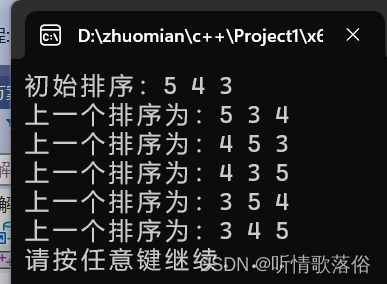c++全排列
发布时间:2024年01月13日
目录
next_permutation()函数
next_pernutation()函数用于生成当前序列的下一个排序。它按照字典序对序列进行重新排序,如果存在下一个排列,则将当前序列更改为下一个排列,并返回true;如果当前序列已经是最后一个排列,则将序列更改为第一个排列,并返回false。
例
#include<iostream>
#include<vector>
#include<algorithm>
using namespace std;
int main()
{
vector<int>nums = { 1,2,3 };
cout << "初始排序:";
for (int num : nums)
{
cout << num << " ";
}
cout << endl;
//生成下一个排序
while (next_permutation(nums.begin(), nums.end()))
{
cout << "下一个排序为:";
for (int num : nums)
{
cout << num << " ";
}
cout << endl;
}
system("pause");
return 0;
}结果:

perv_permutation()函数
perv_permutation()函数与next_permutation()函数相反,它用于生成当前序列的上一个序列。它按照字典序对序列进行重新排序,如果存在上一个序列,则将当前序列改为上一个序列,并返回true;如果当前序列已经是第一个序列,则将序列更改为最后一个序列,并返回false。
例
#include<iostream>
#include<vector>
#include<algorithm>
using namespace std;
int main()
{
vector<int>nums = { 5,4,3 };
cout << "初始排序:";
for (int num : nums)
{
cout << num << " ";
}
cout << endl;
//生成上一个排序
while (prev_permutation(nums.begin(), nums.end()))
{
cout << "上一个排序为:";
for (int num : nums)
{
cout << num << " ";
}
cout << endl;
}
system("pause");
return 0;
}结果:

文章来源:https://blog.csdn.net/weixin_63201442/article/details/135490966
本文来自互联网用户投稿,该文观点仅代表作者本人,不代表本站立场。本站仅提供信息存储空间服务,不拥有所有权,不承担相关法律责任。 如若内容造成侵权/违法违规/事实不符,请联系我的编程经验分享网邮箱:chenni525@qq.com进行投诉反馈,一经查实,立即删除!
本文来自互联网用户投稿,该文观点仅代表作者本人,不代表本站立场。本站仅提供信息存储空间服务,不拥有所有权,不承担相关法律责任。 如若内容造成侵权/违法违规/事实不符,请联系我的编程经验分享网邮箱:chenni525@qq.com进行投诉反馈,一经查实,立即删除!